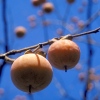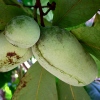It is not to late to plant new trees into your garden landscape. Before selecting fruit or nut trees for your garden you should consider some of Americas Native Fruit and nut trees.
Often they will survive and even thrive in places and climates where hybrid trees will fail.
Native trees are well adapted to your soil type, weather and rainfall without a lot of hands on fussing and messing about to keep them alive.
Source American Persimmon
 American persimmon (Diospyros virginiana) has received a bad rap, mostly due to the awful sensation that comes from eating the unripe fruits. But when ripe, the fruits actually have a rich, honeylike flavor and jellylike texture.
American persimmon (Diospyros virginiana) has received a bad rap, mostly due to the awful sensation that comes from eating the unripe fruits. But when ripe, the fruits actually have a rich, honeylike flavor and jellylike texture.
Native from Connecticut to Florida and west to Kansas, persimmon trees grow about 50 feet tall and look handsome in the home landscape.
Persimmon pollination can be a little tricky to understand. Sometimes the male trees produce female flowers and vice versa. The easiest way to get fruits is to plant a self fertile female tree, such as ‘Garretson’ or ‘Meader’. To get fruit from the other varieties, you’ll need to plant both sexes, or graft a male branch onto a female tree.
American Native Juneberry
American Native Juneberry Plant one of these 25 to 30 foot trees for its white or reddish spring blossoms and vibrant autumn foliage. Don’t overlook the tasty, edible fruit. The small blue, red, or white berries have a unique sweet flavor that hints of almond.
Juneberry trees and shrubs (Amelanchier spp.) grow wild throughout North America and are known by various other names, including saskatoon, shadblow, and sarvis or serviceberry. All species bear edible fruits, but the tastiest ones are found on the Allegheny serviceberry (A. laevis), the thicket serviceberry (A. canadensis), the saskatoon (A. alnifolia), and a hybrid, the apple serviceberry (A. grandiflora). Good varieties for fruit and beauty include ‘Ballerina’, ‘Cumulus’, and ‘Robin Hill’.
American Native Pawpaw 
American Native Pawpaw Try a pawpaw the northernmost member of the custard apple family and cousin to the cherimoya and soursop. The 10 to 25 foot trees (Asimina triloba) are native to woodlands from New York to Georgia and west to Nebraska, their lush, drooping leaves give them an exotic appeal. The smooth, creamy fruits taste something like a banana with hints of mango and pineapple. They often weigh as much as a pound apiece. You can grow pawpaws if you live within Zones 5 through 8.
For the best fruits, plant ‘Overleese’, ‘Mitchell’, ‘Taytwo’, or ‘Sunflower’, advises the PawPaw Foundation. Plant at least two different varieties to ensure good pollination.
American Native Mayhaw
Mayhaw (Crataegus aestivalis, C. opaca, and C. rufula) is a southern edible hawthorn that ripens in May. The fruits vary in color from yellow to bright red, range in size from 1/3 to 2/3 inch across, and taste similar to a tart crabapple.
The broad topped thorny trees are an attractive addition to the landscape especially in early spring when they burst into a cloud of white to pale pink blossoms. They grow about 25 feet high and should be spaced at least 20 feet apart.
Plant at least two mayhaws to ensure cross-pollination and maximum fruit production. The trees grow and produce best in Zones 6 to 9.
American Native Mulberry
American Native Mulberry fruits look like blackberries but range in color from deep black to red to lavender to pure white. Their flavor ranges from strictly sweet to tangy sweet. Many “wild” mulberries actually aren’t fully native, but are “half-breeds” the result of a cross between our native red mulberry (Morus rubra) and the Chinese white mulberry (M. alba). Although some female trees need a male pollinator, many cultivars set fruit without pollination.
The most widely available cultivar, ‘Illinois Everbearing’, grows well throughout most of North America and bears large, tasty, nearly seedless fruits throughout the summer. And like most mulberry varieties, it needs no cross-pollination.
If you see or read something you like Please Share By Emailing It To A Friend.
Not from the USA. Please leave me comment about your home town and country.
Why is common sense so uncommon?
Don’t be Shy. Leave me your Comment(s)

Totally agree! This year we tried to go heavily “native” on our trees. We planted 4 pawpaws, 4 Arkansas Black Apples, 4 native mulberries, and 2 each Albemarle Pippin and Spitzenberg which I don’t know that they are native to America, but certainly would be considered “early settlers”…great post!
LikeLike
Thank you so much for checking out my blog. I am excited to learn from your vast gardening experience!
LikeLike
Re: Thank you for your kind comment.
However, I’m just an old country guy that attempts to pass on some of my hard learned lessons in gardening.
Happy spring gardening
LikeLike
I grew up with a pawpaw tree at home and a persimmon at my grandparents’ house. I only ever ate ripe ones, and they were phenomenal! I should visit the old homestead to see if it’s still alive… our pawpaw tree never bore fruit, though. Needed a pollinator perhaps, or more sun. Hm…
LikeLike
Re: Julia Swancy Contrary to what the ‘experts’ will tell you, Pawpaw’s do not do well in my hot windy low rainfall climate.
Happy spring gardening
LikeLike
Ah, that might be it. We have high rainfall but killer heat in Georgia. Happy gardening to you too!
LikeLike
I have multiple mulberry trees and saskatoon berry shrubs but I had not heard of the others. I will have to look into them, thank you.
As an added note – saskatoon berries taste like blueberries with a hint of almond.
LikeLike
You’re a world of information!
LikeLike
Re: Thank you for your kind comments.
I think I just get luck once in a while 🙂
Smiling … Plant a native fruit tree or bush
LikeLike